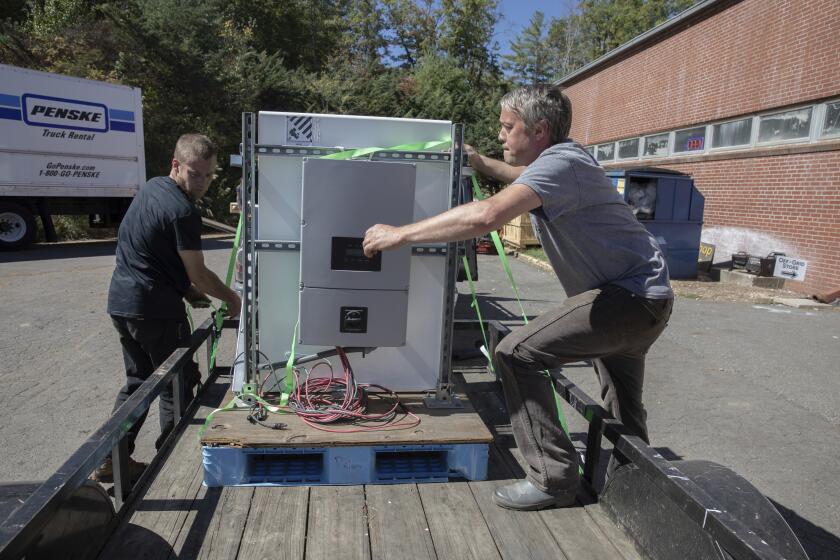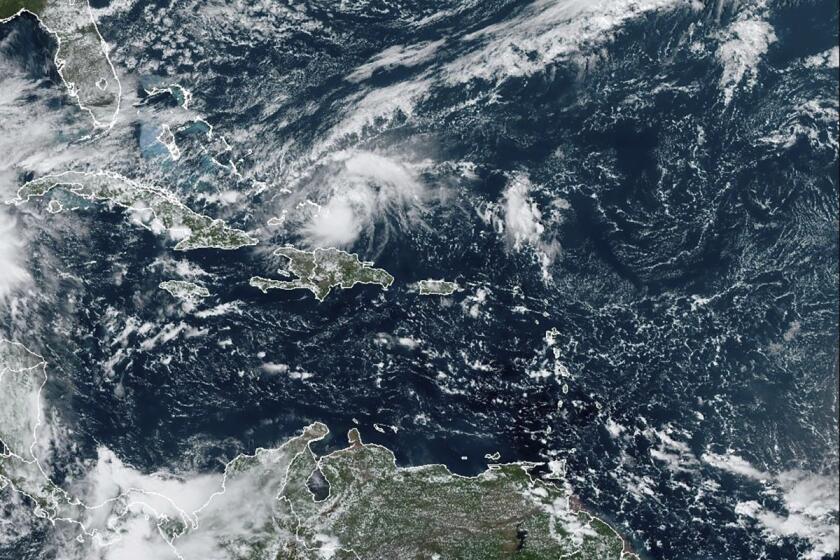Hurricane Rafael forecast to strengthen to powerful Category 3 storm before hitting Cuba

- Share via
HAVANA — Hurricane Rafael barreled toward Cuba on Wednesday, forecast to make landfall in western Cuba as a major Category 3 hurricane that forecasters warn could bring “life-threatening” storm surges, winds and flash floods.
Thousands of people in the west of the island were evacuated as a prevention measure before Rafael was expected to slam into Cuba on Wednesday after dumping rain on Jamaica and the Cayman Islands on Tuesday.
Classes and public transport were suspended on parts of the island as authorities issued an alarm for the incoming weather for the west of the country. Workers secured buildings and cleaned up garbage along Havana’s coastline in preparation for floods.
“Preparations to protect life and property should be rushed to completion,” warned the National Hurricane Center in Miami.
Rafael — currently classified as a Category 2 hurricane — was located about 60 miles east-southeast of the Isle of Youth and around 130 miles south-southeast of Havana on Wednesday. It had maximum sustained winds of 110 mph and was moving northwest at 14 mph , according to the center.
Forecasters expected the storm to later weaken over Cuba before emerging in the southeastern Gulf of Mexico as a hurricane.
in Hurricane Helene’s aftermath, residents who can get their hands on gas and diesel-powered generators are depending on them, but that is not easy.
Cubans have already been struggling with blackouts while recovering from another hurricane two weeks ago that killed at least six people in the eastern part of the island.
The U.S. State Department issued an advisory for Cuba on Tuesday afternoon, offering departure flights to nonessential staff and American citizens, and advising others to “reconsider travel to Cuba due to the potential impact of Tropical Storm Rafael.”
On Tuesday morning, the Cuban Civil Defense called on Cubans to prepare as soon as possible, because when the storm makes landfall “it’s important to stay where you are.”
A hurricane warning was in effect on Wednesday for a portion of the Cayman Islands and the Cuban provinces of Pinar del Rio, Artemisa, La Habana, Mayabeque, Matanzas and the Isle of Youth.
A tropical storm warning was in effect for the Cuban provinces of Villa Clara, Cienfuegos, Sancti Spiritus and Ciego de Avila, as well as the lower and middle Florida Keys from Key West to west of the Channel 5 Bridge, and Dry Tortugas.
The storm on Tuesday knocked out power in parts of Jamaica and unleashed flooding and landslides. The Jamaica Public Service, the island’s electricity provider, said in a statement late Tuesday that impassable roads were preventing crews from restoring power in some areas.
Meanwhile, crews in Little Cayman and Cayman Brac were expected to fan out early Wednesday to assess damage after a direct hit late Tuesday.
Forecasters said 5 to 10 inches of rain are expected across eastern Cuba through Tuesday, with some isolated locations getting up to 15 inches.
Power outages were reported across the Cayman Islands, and schools remained closed on Wednesday.
“While conditions have improved on Grand Cayman, residents are advised to exercise extreme caution on the roads and near coastlines as rough seas and residual flooding risks may persist,” the government said in a statement.
Forecasters warned Rafael would unleash heavy rains across the western Caribbean that could lead to flooding and mudslides in parts of Cuba and the Cayman Islands.
Heavy rainfall also was expected to spread north into Florida and nearby areas of the southeast U.S. during the middle to late part of the week. The Hurricane Center predicted storm surges in Florida could reach 1 to 3 feet in Dry Tortugas and 1 to 2 feet in the Lower Florida Keys. A few tornadoes also were expected Wednesday over the Keys and southwestern Florida.
Rafael is the 17th named storm of the season.
The National Oceanic and Atmospheric Administration predicted the 2024 hurricane season was likely to be well above average, with between 17 and 25 named storms. The forecast called for as many as 13 hurricanes and four major hurricanes.
An average Atlantic hurricane season produces 14 named storms, seven of them hurricanes and three major hurricanes.
Rodríguez writes for the Associated Press. Associated Press reporter Megan Janetsky contributed to this report from Mexico City.
More to Read
Sign up for Essential California
The most important California stories and recommendations in your inbox every morning.
You may occasionally receive promotional content from the Los Angeles Times.












